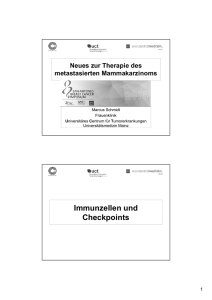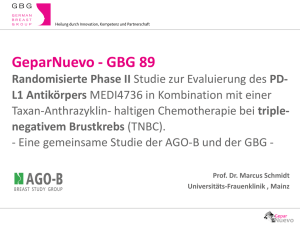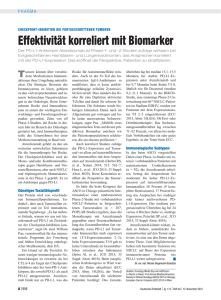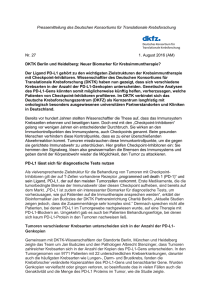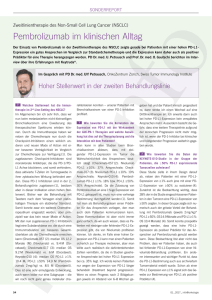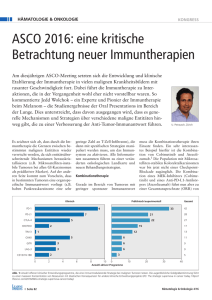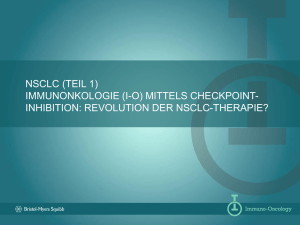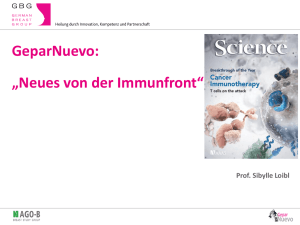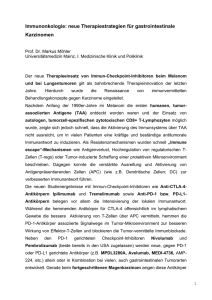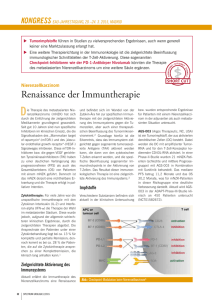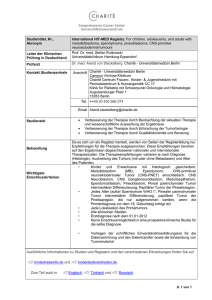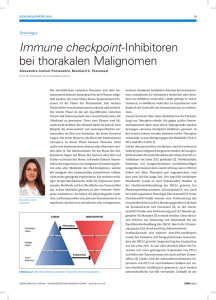Als PDF herunterladen
Werbung
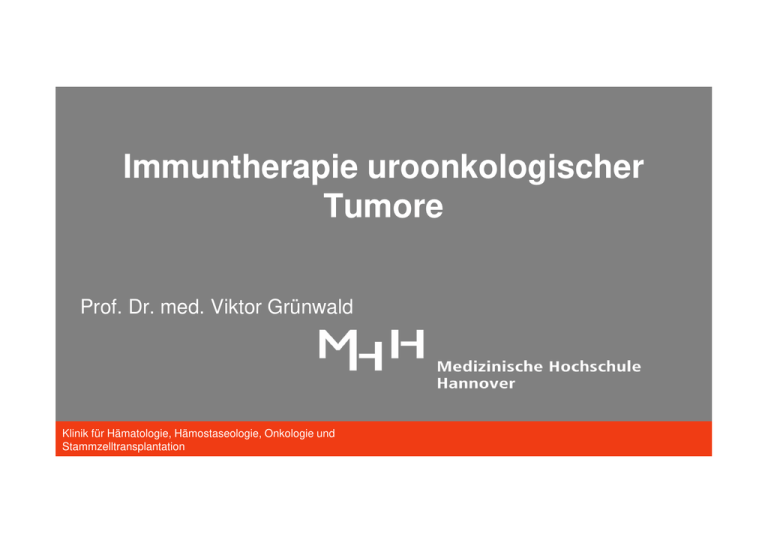
Immuntherapie uroonkologischer Tumore Prof. Dr. med. Viktor Grünwald Klinik für Hämatologie, Hämostaseologie, Onkologie und Stammzelltransplantation Disclosures Compensated lectures: BMS, Ipsen, Eisai, Novartis, Pfizer, Roche Advisory: Bayer, BMS, Cerulean, Ipsen, Eisai, Novartis, Pfizer, Roche Speaker‘s bureau: Novartis, Pfizer Research grants, stock shareholder: none Checkpunkt Blockade GU Tumore Status Ergebnis Nierenzellkarzinom Phase III positiv Blasenkarzinom Phase III positiv Prostatakarzinom Phase III negativ Hodenkarzinom Basket Studie - Peniskarzinom Basket Studie - PD-L1+ als negativer Prädiktor PCA NCC Das Bild k ann zurzeit nicht angezeigt werden. Gevensleben et al. (2016). CCR, 22(8), 1969–1977. Thompson et al. Proc Natl Acad Sci USA 2004;101:17174–9. Cierna et al. (2016). Annals of Oncology, 27(2), 300–305. GCT PD-L1 beim Peniskarzinom Gut diff. Moderat diff. Schlecht diff. Udager et al. (2016). Annals of Oncology, 27(9), 1706–1712. http://doi.org/10.1093/annonc/mdw216 62% PD-L1+ N=37 Assoziation mit fortgeschrittenem Stadium Inflammatorisches TCC – besseres OS PD-L1+ TIMC analysed 23 mo. 12 mo. TIMC: tumor infiltrating monocytic cells Bellmunt et al. (2015). Annals of Oncology, mdv009. doi:10.1093/annonc/mdv009 PCA: Ipilimumab vs. Placebo Kantoff et al. (2010). NEJM, 363(5), 411–422. Mutationsspektrum solide Tumore MS Lawrence et al. Nature 2013 PD-L1 ist nicht gleich PD-L1 Oncogene PD-L1 expression + Adaptive immunevasion Oncogen driven PD-L1 expression Immune cells Tumor cells, strong PD-L1+ Topalian et al. (2016). Nature Reviews Cancer, 16(5), 275–287. http://doi.org/10.1038/nrc.2016.36 Tumor cells PD-L1 nur im Kontext beurteilen H&E PD-L1 TILs (CD3+) NSCLC (primary) ZNS mets. N=146 paired lesions, 73 cases. Discrepencies: 14% (tumor), 26% (TILs) Mansfield et al. (2016). Annals of Oncology, mdw289. http://doi.org/10.1093/annonc/mdw289 Immuntherapie – kein one-size-fits-all approach hot tumor A B cold tumor Nonimmunogenic tumor microenvironment CD8 T cell wit h granzym e B CD8 T cell single agent CD4 T cell Tum or cell wit h PD-L1 expression CD8 T cell CD8 wit h CD45RO T cell expression wit h PD-L1 expression Com binat ion t herapies with agent s t hat cr eat e im m unogenic t um or m icroenvironm ent and im m une checkpoint t her apy combination Immunogenic tumor microenvironment Im m une checkpoint ther apy and durable clinical benef t Durable clinical benef t Sharma & Allison. The future of immune checkpoint therapy. (2015). The future of immune checkpoint therapy. Cancer Immunology Immunotherapy, 1–7. Bevacizumab/Atezolizumab – verbessert T-Zell-Migration Wallin et al. (2016). Nature Communications, 7, 12624. http://doi.org/10.1038/ncomms12624 IC3 RCC Patient: PR unter ATEZO Herbst et al. (2014). Nature, 515(7528), 563–567. http://doi.org/10.1038/nature14011 Duale Checkpoint Blockade – die zukünftige Therapie des mRCC? IPI3 + NIVO1 IPI1 + NIVO3 ORR 40% 40% PD 17% 17% PFS 6,6 Mo. 9,1 Mo. Hammers et al. ASCO 2015 #4516. Hammers et al. ESMO 2016: 1062P Resistenzmechanismen Erworbene Resistenz (MM) IFNγ-Resistenz − JAK1/2 mt. MHC-I Expr. − B2M mt. Zaretsky et al. (2016). NEJM, NEJMoa1604958. http://doi.org/10.1056/NEJMoa1604958 Primäre Resistenz: JAK Mutationen Shin et al. (2016) Cancer Discovery, 1–37. http://doi.org/10.1158/21598290.CD-16-1223 Was unterscheidet TKI von IO? Besseres PFS unter TKI Motzer et al. (2015). NEJM, 150925150201006–11. Choueiri et al. (2016). Lancet Oncol, pp. 1-11. Bessere Verträglichkeit für IO McDermottet al. (2016). JCO, 34(8), 833–842. Motzer RJ et al. N Engl J Med, 2015; 373: 1803–13. Choueiri et al. (2016) Lancet Oncology, 17(7), 917–927. http://doi.org/10.1016/S1470-2045(16)30107-3 Immuntherapie: bessere QoL Cella, D., Grünwald, V., Nathan, P., Doan, J., Dastani, H., Taylor, F., et al. (2016). Lancet Oncology, 17(7), 994–1003. http://doi.org/10.1016/S1470-2045(16)30125-5 Risiken der Immuntherapie: Aggravation der Erkrankung Champiat et al. (2016). CCR.1741.2016. http://doi.org/10.1158/10780432.CCR-16-1741 NIVOSWITCH early switch to PD-1i • • • • • • ccRCC 1st line TKI for 1012 wks. PR or SD ECOG: 0-2 MSKCC: all No intolerance N=244 I°: OS rate at 2 years II°: ORR, OS, PFS Nivolumab 3mg/kg q2Wo. R TKI continuation SUNNIFORECAST Sunitinib vs. Nivolumab+Ipilimumab as First line Treatment Of Renal cell Cancer of nonclear cell SubTypes – an international prospective randomized trial Phase II: N~284 pts. Key Inclusion Criteria • Metastatic or locally advanced nccRCC: papillary, chromophobe, collecting duct carcinoma (CDC), renal medullary carcinoma (RMC), or translocation tumors and NOS • Available tumor tissue • Measurable disease as per RECIST v1.1 • ECOG performance status 0-2 • No prior systemic therapy for RCC • No active CNS metastases • No TKI contraindications Strata: •Histological subtype •MSKCC score: Risk poor vs. other Start Date: Q3/2016 Estimated Study Completion Date: Number of Sites ~30 (A, D, F, S, P) PI: Prof. Dr. Lothar Bergmann, Frankfurt Co-Invest.: PD Dr. Peter Goebell, Erlangen Nivolumab 3 mg/kg IV Ipilimumab 1 mg/kg IV q3w for 4 doses R 1:1 then Nivolumab 3 mg/kg IV q2w Sunitinib 50 mg PO once daily for 4 weeks followed by 2 weeks off, every cycle • Primary Endpoint: Survival rate at 12 mths • Key Secondary Endpoints: • Survival rate at 6 and 18 mths • ORR, TTP, OS, Safety, HR-QoL • Exploratory Endpoints: biomarker e.g.PD-L1 expression of tumor, PD-1 expression of T cell subtypes etc. Ziel der adjuvanten Therapie − Heilung (i.e. Gesamtüberleben) Adjuvante TKI-Therapie des NCC ASSURE S-TRAC Ravaud et al. (2016). NEJM. http://doi.org/10.1056/NEJMoa1611406 Haas et al. (2016). Lancet, 387(10032), 2008–2016. http://doi.org/10.1016/S0140-6736(16)00559-6 ASSURE Unverändertes Gesamtüberleben S-TRAC Ravaud et al. (2016). NEJM. http://doi.org/10.1056/NEJMoa1611406 Haas et al. (2016). Lancet, 387(10032), 2008–2016. http://doi.org/10.1016/S0140-6736(16)00559-6 ASSURE NCC: adjuvante Therapie Start Q1 2017 Hochrisiko: − T2 G4 − T3a G3-4 − T3b-c/T4 − TxN+ N=664 I°: DFS Radiologisches Assessment De Velasco et al. (2016). Cancer Immunology Research, 4(1), 12–17. Erste Arbeit zur Pseudoprogression T-Zellen Nekrose Wolchok et al. Clin Cancer Res 2009;15(23) December 1, 2009 Urothelkarzinom Systemtherapie des TCC - 1st Linie 1st Linie: frail Cisplatin/Gemcitabine - (DD-MVAC) - Carboplatin/Gemcitabine - Gemcitabine - Taxane 2nd Linie - Vinflunine - Taxane - (Ifosfamide) Bellmunt et al. ESMO Guidelines Working Group. (2014, September). Annals of Oncology. http://doi.org/10.1093/annonc/mdu223 Chemotherapie beim TCC Erstlinie Zweitlinie ORR: 44% OS: 12,7 Mo. PFS: 7,6 Mo. ORR: 9% PFS: 3 Mo. Bellmunt et al. (2012). JCO, 30(10), 1107–1113. Bellmunt et al. (2009). JCO, 27(27), 4454–4461. http://doi.org/10.1200/JCO.2008.20.5534 Langzeitüberleben unter CTX PCG1 n=312 GC1 n=314 GC2 n=203 MVAC2 n=202 MVAC3 n=129 DD-MVAC3 n=134 PFS (mo.) 7.6 8.3 7.7 8.3 8.2 9.1 2y-PFS rate - - 14% 18% 12 25 5y-PFS rate - - 10% 11% - - OS (mo.) 15.8 12.7 14 15.2 14.1 15.5 2y-OS rate - - 25% 31% 25 35 5y-OS rate 17%* 16%* 13% 15% 10%§ 14%§ 1Bellmunt et al. (2012). JCO, 30(10), 1107-1113 der Maase et al. (2005). JCO, 23(21), 4602–4608. 3Sternberg et al. (2001). JCO, 19(10), 2638–2646. 2van • • • • • • IMvigor210: Inoperable locally advanced or metastatic urothelial carcinoma Predominantly TCC histology Tumor tissue evaluable for PD-L1 testinga Cohort 1 (n=119): 1L Cisplatin ineligible Atezolizumab 1200 mg IV q3w until RECIST v1.1 progression Cohort 2: Platinum-treated mUC Atezolizumab 1200 mg IV q3w until loss of clinical benefit Cohort 1-specific inclusion criteria No prior treatment for mUC (>12 mo since perioperative chemo) ECOG PS0–2 Cisplatin ineligibility1 based on ≥1 of the following: • Renal impairment: GFR <60 but >30 mL/minb • ≥Grade 2 hearing loss or peripheral neuropathy • ECOG PS2 aPD-L1 Primary endpoint • Confirmed ORR: RECIST v1.1 (per central IRF) Key secondary endpoints • DOR, PFS, OS, safety IRF, independent review facility; TCC, transitional cell histology, ClinicalTrials.gov ID: NCT02108652. prospectively assessed by a central laboratory, with patients and investigators blinded. bCockcroft-Gault formula. 1Galsky J Clin Oncol 2011. Mod. Balar AV et al. ASCO 2016, Oral Abstract Session – Genitourinary (Nonprostate) Cancer, Abstract No. LBA4500 1st Linie TCC: Atezolizumab (Platin-ungeeignet) 57% Bellmunt et al. ESMO 2016, 782PD • • • Locally advanced or metastatic urothelial carcinoma Predominantly TCC histology Tumor tissue for PD-L1 testinga Cohort 2-specific inclusion criteria • Progression during/following Platinum (no restrictions on # prior lines of therapy) • ECOG PS 0–1 • CrCl ≥30mL/min Median follow-up: 17.5 months (range, 0.2 to 21.1+ mo) Cohort 1 (n=119) 1L Cisplatin ineligible Cohort 1 presented earlier this morning1 Cohort 2 (n=310) Platinum-treated mUC Atezolizumab 1200 mg IV q3w until loss of benefit Co-primary endpoints: • ORR (confirmed) per RECIST v1.1 by central review • ORR per immune-modified RECIST by investigator Key secondary endpoints • DOR, PFS, OS, safety Key exploratory endpoints • Biomarkers (To be presented by Rosenberg et al., Abstract #1042) TCC, transitional cell carcinoma. aPatients and investigators blinded to PD-L1 ICH status. Trial Identifier: NCT02108652.1Balar ASCO 2016 [abstract LBA4500]. 2Rosenberg ASCO 2016 [abstract 104].) Gesamtüberleben: Atezolizumab Loriot et al. ESMO 2016: 783P IC0/1 n=210 IC2/3 n=100 Alle Pts. N=310 OS; Mo. (95% CI) 6,7 (5,4-8,0) 11,9 (9,0-NE) 7,9 (6,7-9,3) 12-Mo. OS 31% 50% 37% Nivolumab (Platin-vorbehandelt) Median OS, Months (95% CI)a Overall Survival (Probability) 1.0 8.74 (6.05–NR) 5.95 (4.30–8.08) 11.30 (8.74–NR) All treated PD-L1 <1% PD-L1 ≥1% 0.9 0.8 0.7 0.6 0.5 PD-L1 ≥1% 0.4 All treated patients 0.3 PD-L1 <1% 27% mit Vinflunin 22% mit BSC 0.2 ca. 40% 0.1 0.0 0 No. at Risk All treated patients 265 PD-L1 <1% 143 PD-L1 ≥1% 122 aSimilar 3 6 198 101 97 148 69 79 Months 9 12 15 63 26 37 5 2 3 0 0 0 results were seen using the 5% PD-L1 tumor expression cutoff; NR, not reached Galsky et al. ESMO 2016: LBA31 Checkpunkt Blockade beim TCC ATEZO1 ATEZO2 NIVO3 NIVO4 PEMBRO5 AVELU6 N 119 310 78 270 100 129 Linie CDDP ungeeignet ≥2. ≥2. ≥2. CDDP ungeeignet ≥2. oder CDDP ungeeignet CR (%) 7 7 6 2 6 3 PR (%) 17 16 18 17 18 14 OS (mo.) 14.8 7.9 9.7 8.7 - - 1Balar et al. ASCO 2016 #4500. 2Dreicer et al.ASCO 2016 #4515. 3Sharma et al. ASCO 2016 #4501. et al. ESMO 2016 LBA31. 5Balar et al. ESMO 2016 LBA32. 6Patel ESMO 2016: 2534 4Galsky SAUL Studie Testsubstanz: Atezolizumab Einschlusskriterien: • Lokal fortgeschrittenes (T4, jedes N oder jedes T, N 2-3) oder metastasiertes Urothelkarzinom (M1, Stage IV) oder nicht-urotheliales Karzinom • Zweitlinienchemotherapie geeignet TCC: wenig aktivierende Mutationen TCGA network. (2014). Comprehensive molecular characterization of urothelial bladder carcinoma. Nature, 507(7492), 315–322. doi:10.1038/nature12965 Neue Ansätze zur molekularen Rx TCGA network. (2014). Comprehensive molecular characterization of urothelial bladder carcinoma. Nature, 507(7492), 315–322. doi:10.1038/nature12965 Molekulare Therapiestudien Substanz Inhibition Phase Mol. Stratum* offen Ident BEZ235 PI3K/mTOR II + - NCT01856101 Buparlisib PI3K II NR (+) NCT01551030 Dovitinib VEGFR/FGFR II + - NCT01732107 BGJ398 FGFR I/II + + NCT01004224 Nintedanib VEGFR/FGFR II + - NCT02278978 BAY1163877 FGFR I/II + + NCT01976741 LY3076226 FGFR3 mAb I + + NCT02529553 B-701 FGFR3 mAb II + + NCT02401542 Palbociclib CDK4/6 II + + NCT02334527 *Stratifizierung nach Mutation, Amplifikation, Überexpression, Aktivierung und/oder Wildtyp www.clinicaltrials.gov FGFR Inhibition Testsubstanz: Erdafitinib (pan FGFR Inhibitor) Einschlusskriterien: • metastasiertes oder inoperables Urothelzellkarzinom (cT4b, N+ oder M+) • progrediente Erkrankung • FGFR mutiert Zusammenfassung • Adjuvante Therapie – noch kein Standard beim NCC • Erstlinie: neuer Standard in 2017 möglich • Zweitlinie: Nivolumab, Cabozantinib & Lenvatinib/Everolimus sind Optionen mit OS-Vorteil • Keine Rationale in der Therapieauswahl • PD-L1 ist kein optimaler prädiktiver Marker • Kombinationen und Therapieoptimierung sind aktuelle Studienkonzepte
